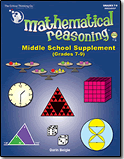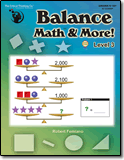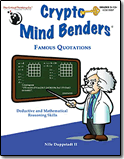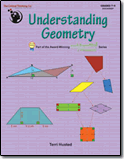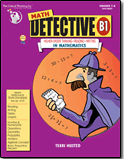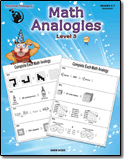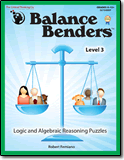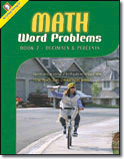Math Activities for Middle School Enrichment: Critical Thinking at a Critical Age
Gifted Free Activities for Middle School Students
May 1, 2018, by The Critical Thinking Co. Staff
Good Mathematical Habits for Young Adolescents
Mathematics content is best learned in a way that fosters good habits of mathematical thinking. The Common Core State Standards in Mathematics (www.corestandards.org) supplement their K-12 standards for content with eight standards for mathematical practice:
- Make sense of problems and persevere in solving them.
- Reason abstractly and quantitatively.
- Construct viable arguments and critique the reasoning of others.
- Model with mathematics.
- Use appropriate tools strategically.
- Attend to precision.
- Look for and make use of structure.
- Look for and express regularity in repeated reasoning. These mathematical practices, and how they relate to content, mean very different things depending upon student age.
Middle School as a Critical Transition Period
The middle school years mark a critical transition in a child’s cognitive development – how a child thinks and learns. Generally at age 11 or 12 children enter the fourth and final stage in Piaget’s four stages of cognitive development, called the formal operational stage. During this time children show significant growth in their ability to think abstractly, use advanced reasoning skills, make hypotheses and inferences, and draw logical conclusions. Ideally, the middle school years provide educators with new opportunities to foster good thinking habits and mathematical practices.
The Balance Between Mathematical Content and Practice
Students begin middle school exposed to mathematics as a very broad subject covering a wide array of topics: 2D geometry, probability, percentages, number theory, logic, patterns, statistics, graphing, number operations, proportions, elementary algebra, 3D geometry, and so on. They finish middle school and begin high school usually embarking on year-long studies of content-intensive mathematical subject areas: a year of Algebra 1, then a year of Geometry, then a year of Algebra 2, and so on. Though young adolescents begin middle school ready to think with more power, creativity, and independence, the accompanying increase in content expectations means that a balance between mathematical content and practice can be difficult to achieve. Developing good thinking and learning habits requires investment of time and patience, and well-intended educators can be drawn away from quality mathematical practices when the drive to learn content becomes too formidable.
Committing to Critical Thinking at the Middle School Level
Content can be learned in ways that ask young adolescents to harness and develop their new cognitive abilities. For example, a traditional 2D geometry question might ask:
Calculate the perimeter and area of a rectangle with a 15-inch length and a 9-inch width.
This question can be answered by performing a routine calculation using formulas for the perimeter and area of a rectangle. Similar content can be studied with a question that asks for critical thinking:
For what whole number values of length and width will the rectangle have an area of 60 square yards and a perimeter of 38 yards?
This second question (from Mathematical Reasoning™ Middle School Supplement) requires students to develop a strategy to construct a solution. Indeed, a common approach involves making a mental or physical list of pairs of whole numbers that multiply to 60 and then searching for the pair of numbers that add up to 19 (since a rectangle’s perimeter is twice the sum of the length and width). The correct answer is a length of 15 inches and a width of 4 inches (assigning the larger number to length). Note the depth and value of a critical thinking opportunity: the solution strategy connects 2D geometry with the number theory technique of factoring and is a precursor to a more sophisticated factoring procedure used in Algebra 1. The second question requires greater time investment than the first question, but is worth the extra time if one is committed to young adolescents learning content in a way that fully engages their reasoning skills.
Fostering Perseverance
The first Common Core mathematical practice standard emphasizes the need to have students make sense of problems and persevere in solving them. The most important ingredient in Polya’s classic four-step problem solving strategy is the act of making decisions, as opposed to simply applying an algorithm that has been instructed. Young adolescent reaction to problem solving and decision making can be decidedly mixed. On the one hand, playing an active role in the solution process – figuring something out and being creative – can be fun, exciting, sometimes even addicting for young minds that are ready to be engaged. However, overcoming obstacles and persevering with a task that requires multiple steps and authentic reasoning can also sometimes be discouraging for early adolescent brains just learning how to tap into their emerging powers. The frustration level can depend on the difficulty level of the problem-solving situation, and a common, safe path is to keep decision making and creative expectations down to a minimum. However, if mathematics education in the United States is to reach a higher standard against a worldwide benchmark, children must be encouraged to persevere with critical thinking and decision making, to embrace both the excitement and occasional frustration of authentic reasoning and creativity.
Enrichment Activities to Stimulate Critical Thinking
The Critical Thinking Co.™ specializes in activities that stimulate use of reasoning skills and creativity when learning content. These enrichment activities challenge students to make decisions and construct solutions – to play an active role when learning content. Variety is favored over repetition, although care is taken to have common themes emphasized and connections reinforced. Presentation is often graphic intensive, resulting in visual appeal to young eyes. Real-world applications are easily identifiable. Problem-solving is supported with clear, comprehensive solutions and explanations. An example is provided with the activity sets Dimension Detective and Linear Patterns and accompanying solution pages from Mathematical Reasoning™ Middle School Supplement. In Dimension Detective students deduce missing dimensions for a variety of geometric shapes by using proportional reasoning, number theory ideas, and connections between 2D and 3D shapes. In Linear Patterns students determine number patterns and geometric patterns, and then deduce algebraic expressions to describe these patterns (a precursor to creating algebraic equations to describe linear graphs). Each activity set is accompanied by needed math facts, strategy tips, and comprehensive solutions that teachers and parents can use to help support student investigations. These sorts of enrichment activities provide middle school students with an opportunity to explore mathematical content, create or reinforce ideas, make connections, and use abstract reasoning. Young adolescents have emerging cognitive powers to accompany their rapid physical growth, and math enrichment can provide middle school students with appealing opportunities to use their maturing reasoning skills.
Free Printable Math Worksheets for Grades 6-9
- Dimension Detective (Number Theory)
- Linear Patterns
- Geometry & Introduction to Trigonometry
- Uncovering All the Angles
- Algebraic Cryptograms
- The Finest Pyramid
Visit our product pages to find hundreds more free printable activities.
Award-Winning Math Books for Middle School Students
Here's what some of our customers have said regarding the use of The Critical Thinking Co.™ math products for middle school enrichment.
"Mathematical Reasoning presents math in a way that makes it not only simple to learn, but also practical to apply to everyday circumstance (obviously making math more meaningful to him)." - Katherine, Mississippi
"My son hated math. I saw your curriculum and gave it a try. Wow, what a great fit for my son! Your Mathematical Reasoning curriculum gave him a way to learn math that made sense to him. Thank you!" - Amy, Ontario, Canada
"Critical Thinking has uniquely captured the method of teaching students not only how to think logically, but to apply logic to the process of learning in every subject area. [M]any companies have begun to jump on the bandwagon and produce materials that use the critical thinking label, but the contents are the same old drill and practice, and our students know the difference right away. - Peggy, educator, Tucson, AZ
"For 12 years, I've recommended your company to my teacher-training students. Your materials are exceptionally valuable to teachers. Critical Thinking not only produces quality materials, but your fine company is unusually responsive to needs and questions of the individual teacher as well as of the big school districts." - Dr. Leonard Martin, Teacher Education Program, University of Denver





